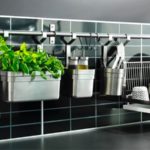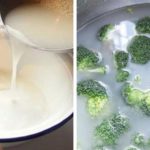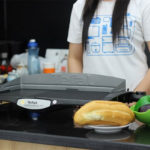Vegetables and fruits are essential foods in family meals. This food group provides fiber and essential vitamins and minerals for the body. However, during the growth of vegetables and fruits, farmers often use pesticides and insecticides, so there may still be residual amounts in the vegetables.
If the residual pesticides on fruits and vegetables are not removed, they will definitely have an impact on health in the long run. Therefore, let’s refer to the effective methods below to remove residual pesticides from fruits and vegetables.
Soaking and rinsing

Pesticides in fruits and vegetables are difficult to dissolve in water, so the soaking and rinsing method can only remove a portion of the pesticides. However, rinsing with water is still a basic method to remove dirt and other residual pesticides on vegetables and fruits. This method can mainly be used for leafy green vegetables such as spinach, lettuce, cabbage, coriander, and parsley.
The general procedure is to wash away the dirt on the surface of the vegetables with clean water first, then soak them in clean water for 10-20 minutes. Finally, rinse again with water 2-3 times after soaking.
Rice water soaking method

Before cooking rice, families often rinse the rice several times with clean water. Instead of pouring the rice water, you can use it to wash vegetables because rice water is acidic, and pesticides on vegetables are also acidic. The rice water will gradually decompose and lose its effect, reducing harmful substances in the vegetables.
In addition, rice water has a certain viscosity and can absorb some pesticides and chemicals on the surface of fruits and vegetables. Moreover, rice water does not contain other chemicals, so it is safer to use rice water to clean fruits and vegetables. Washing berries such as strawberries, raspberries, and grapes with rice water has excellent results!
Hot water blanching method

Most pesticides used on fruits and vegetables are used to kill insects. These chemicals are easily degraded at high temperatures, so using boiling water to blanch fruits and vegetables is very effective in removing residual pesticides.
However, this method also has a major disadvantage, which is that many types of vegetables and fruits will wither after exposure to high temperatures. Therefore, leafy green vegetables are more suitable for this method, such as kale, spinach, coriander, curly kale, celery, cabbage, lettuce, chili, beans, and broccoli.
The general procedure is to blanch the vegetables in boiling water for about 1-3 minutes (depending on the type), then remove and rinse them thoroughly, reducing the amount of pesticides in the vegetables.
Saltwater cleaning method

Washing fruits and vegetables with saltwater is almost a common method. Washing vegetables with diluted saltwater (1% – 3%) not only removes some pesticides but also removes hidden insects in the crevices or veins on the back of the leaves. For example, cabbage and other types of vegetables, you can separate these vegetables into individual leaves before cooking, then soak them in saltwater for a while.
When soaking vegetables, it is best to immerse them completely in the saltwater so that the vegetables are fully in contact with the saltwater. The residual plant protection substances on the vegetables will gradually lose their effect after soaking. Then, rinse the vegetables several times with clean water until there is no more oil film on the surface of the water.
Cleaning with baking soda + flour

Flour has a relatively strong adsorption capacity and can absorb various impurities and dirt on fruits and vegetables. However, compared to rice water, the alkalinity of flour water is slightly lower and its ability to degrade residual pesticides is slightly lower. Especially for the degradation of pesticides containing phosphorus, it is best to wash with baking soda. For grapes, cherries, and other fruits, you can add a little flour to baking soda water to increase the thickness of the water, soak for about 15 minutes, shake the grapes repeatedly to clean them, and finally rinse them again with water. This method is very effective in removing pesticides, microorganisms, impurities, etc.
Peeling method

Fruits and vegetables have a relatively large amount of residual pesticides on their surfaces. Some fruits and vegetables have a waxy surface, making it easier to absorb residual pesticides. Therefore, for fruits and vegetables that can be peeled, it is better to peel them before consuming. This is a better, simple, and practical way to remove residual pesticides.
According to Xe và thể thao






































